Patagonia. The word alone stirs up evocative images, but ones that are sometimes misconceived. Is it a desolate hinterland or an Alpine wonderland? In reality, it’s both. One descriptor which is always accurate, however, is ‘remote’ – in fact, there are more people per square mile in Western Sahara than in Patagonia, and it is precisely that idea which captured the imagination of some of the world’s greatest travellers.
Bruce Chatwin wrote “I pictured a low timber house with a shingled roof, caulked against storms, with blazing log fires and the walls lined with the best books” during an Argentine odyssey as chronicled in his book In Patagonia. He noted the beautiful desolation, the vast snow capped peaks and flower carpeted foothills; he adored the strikingly celestial lakes and dreamt of a wonderful escape from the frenetic activity of modern life.
They were words that Paul Theroux almost certainly read as he undertook a more ambitious project two years later in 1979: travelling by train from Boston to Patagonia. The book became the hugely successful The Old Patagonian Express, further adding to the mystique of the region – and firmly placing the train at the heart of Argentina travel.
Patagonia is a vast region that begins around the Rio Colorado, spreads across the Andes to Chile and all the way down to Tierra del Fuego, with Antarctica as the next stop. Travelling in Patagonia has always been fraught with problems. The trains that Theroux once took from Buenos Aires to Esquel are no longer joined up. In an age of cheap air travel and Argentina’s truly excellent buses, the train has simply died out across the country. Yet such is the allure and romance of The Old Patagonian Express that several trains have returned, run by the enthusiast or opportunist.
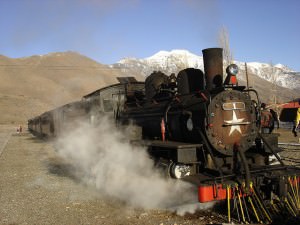
La Trochita train – Photograph by Gustavo Perretto
There are four trains of interest in Patagonia. The Old Patagonian Express – actually called La Trochita (‘the narrow gauge’) until Theroux named his book – runs between Esquel (the final stop for Theroux) and Nahuel Pan, a stop named after the area’s dominant mountain, also known as Mynydd Llwyd – a nod to Welsh ancestors in the area. Although much shorter than the original route, the El Maiten route took seven hours, as La Trochita puffs along with the original 1922 coaches and engine still in use. This area is the Patagonia of desolation. Theroux called it sparse: “There are not even weeds on the ground, only these bushes, and they might well be dead.” But there is a moonscape beauty in these brown mountains, energy in the old train, love in the people of Patagonia and a constant blue sky – the sky that gives the Argentine flag its colour. To the west, however, are the Andes, with lakes for fishing and mountains for skiing.
Today, one of the most popular trips is on the Tren Patagonico. It finishes in Patagonia’s most popular tourist destination: the mountains of the Patagonian Lake District, and its lively centre Bariloche. Both are covered with a thick shag of flowers in spring and summer, and some fine white dust in winter. Horse lovers can follow gauchos on their circumnavigation of the classic seven lakes, before a stew of Patagonian lamb and a bottle of red. The Tren Patagonico runs from Viedma, capital of the province Rio Negro, to Bariloche, 826 kilometres east. It’s no longer steam that powers the train, but it follows the same route it did in 1922, although the addition of a disco carriage and cinema may have shocked those early passengers. There are only weekly trains, leaving Viedma at 8pm on a Friday and arriving the following day for lunch. The return leg leaves Bariloche at 8pm on Sunday.
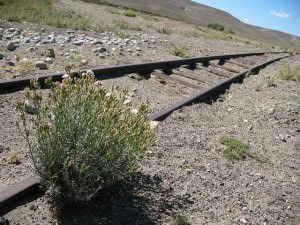
Sparse scrubland next to the tracks in Patagonia – Photograph by Pablo BD
There are several stops along the way. San Antonio Oeste, located on the Gulf of San Matias, is a pleasant natural port that attracts divers and fishing fanatics. Most visitors come to the area for Las Grutas, a nearby beach resort famous for its grottoes (grutas). From here on, it’s a trip into the heart of Patagonia, stopping at historical wool towns, through green valleys and petrified forests, ploughing on through iron tinted earth. From Jacobacci, where Theroux spent a night waiting for the Old Patagonian Express, and the final leg of his journey, the landscape becomes more dramatic, rising up into the Andes and some of the most beautiful parts of Patagonia.
From Bariloche, there’s also the Tren Historico a Vapor, a carefully restored 1912 steam train that travels to Perito Moreno station. The trip includes an asado for lunch, tango show and guided walks around the lakes with their swans and flamingos.
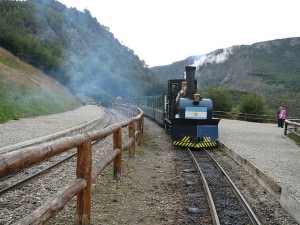
The Train at the End of the World – Photograph by Luis Argerich
The final Patagonian train of this article also has the best name – and it sounds even better in Spanish. El Tren del Fin del Mundo, or the Train at the End of the World, was once used for dumping convicts in the country around the world’s southernmost city. Today, the train carries adventurous tourists for 25 minutes through stunning scenery, over brooks, past waterfalls and the former penal colony and into the Tierra del Fuego National Park. It runs everyday of the year.
Here’s a great video on YouTube of a train leaving Bariloche:

Daniel Neilson

Latest posts by Daniel Neilson (see all)
- RUN BA RUN - July 12, 2016
- A Beginners Guide to Football Teams in Buenos Aires - September 10, 2014
- Argentina Hit Their Stride in World Cup 2014 - June 26, 2014


 Tren de la Costa from Buenos Aires to Tigre
Tren de la Costa from Buenos Aires to Tigre 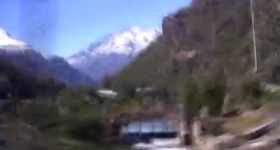 Bingo! Bus Travel in Argentina
Bingo! Bus Travel in Argentina  Penguins of Patagonia – Up Close and Personal
Penguins of Patagonia – Up Close and Personal 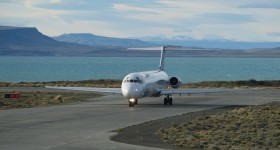 Air Travel in Argentina – A Beginner’s Guide
Air Travel in Argentina – A Beginner’s Guide  Six of the (second) Best: Argentina’s Underrated Destinations
Six of the (second) Best: Argentina’s Underrated Destinations
Great information. I'm looking forward to jumping on The Old Patagonian Express at the end of my journey following in Paul Theroux's footsteps. Take a look at my blog here http://www.rachelpook.com
What an epic journey – I'm jealous! I hope you have a great time.
Daniel
What an epic journey – I'm jealous! I hope you have a great time.
Daniel
[…] Guide – Argentina Transportation GuideHow to travel by train in Central & South AmericaTren Patagonico: Train Travel in Patagonia | Argentina Travel …Argentina travel guide – WikitravelArgentina Transportation – Car, Train, Bus & Taxi […]